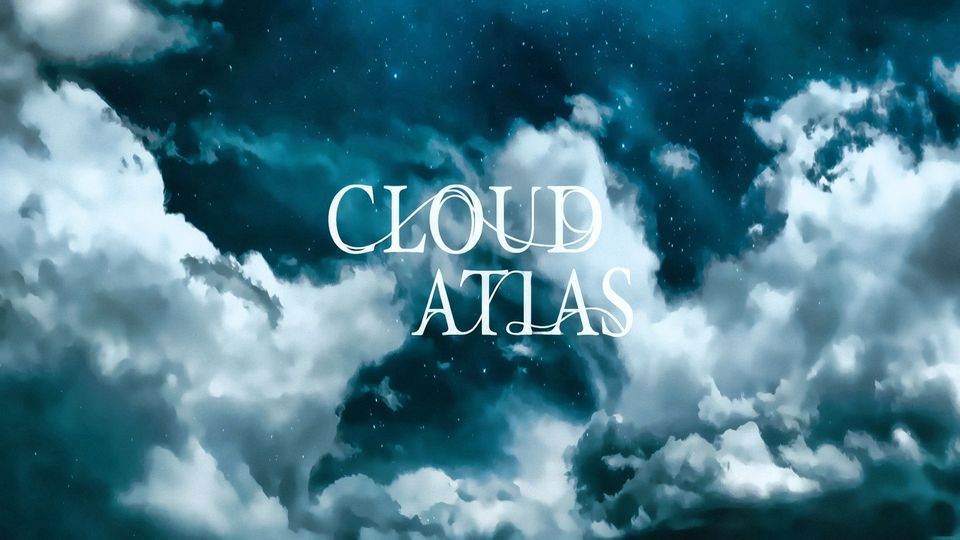Cloud Atlas
explores the cycles of oppression and resistance throughout past and future centuries, demonstrating the causality of such acts in reincarnated souls. Mitchell’s novel focuses not so much on reincarnation, however, as it does on the nature of reality, fiction, and transcendent truths. In an interview with the Washington Post, Mitchell lists Italo Calvino’sIf on a winter’s night a traveler
as his primary inspiration forAtlas
, recalling that it “made a big impression on me when I was an undergraduate.” While Mitchell certainly borrows large elements ofTraveler’s
structure,Atlas
is also a thematic descendant of Calvino’s work. As inTraveler
, characters inAtlas
upset their fictional framework and erode the barrier between author and character; ultimately, this erasure of boundary creates multiple levels of fiction, leaving the reader with the challenge of eliciting meaning from a complex web. This complexity may appear a hindrance to attaining meaning, however the multiple levels of fiction in both Calvino and Mitchell’s works elicit the artificiality of the stories within a novel. This awareness of artificiality leads the reader to bypass questions regarding the specific truth of the story— questions of whether it actually happened—for the higher, immovable truths from which it derives. These postmodern authors use specific, even banal tales to search out transcendent constants.Atlas closely resembles Traveler’s complexity and untraceability, yet Mitchell’s work shies away from its predecessor’s second-person narration. While Calvino’s work achieves a higher level of metafiction, espousing a diegetic voice, Atlas utilizes a purely mimetic voice. Still, Atlas borrows from Traveler in the moments when characters themselves, as opposed to an omniscient narrator, upset their own fictional framework, challenging and validating each story’s authenticity within the larger fictional universe of Atlas. Literary scholar and critic Nella Cotrupi argues that Traveler
“inventories many of the species of metafiction … in a complicated, multilayered, semantically heterogeneous fictional universe … by adopting … the Chinese-box structure of multiple diegetic levels wherein stories successively frame other stories often to the point of infinite regress.
Structurally, Atlas performs a similar feat, its six stories enclosing one another from the middle outward in a potentially endless set of novellas. When crossover occurs between stories, characters often challenge the truthfulness of another story and even the authorial presence itself. Mitchell weaves in a few key self-criticisms through one of the characters, Cavendish, who states: “As an experienced editor, I disapprove of flashbacks, foreshadowings, and tricksy devices; they belong in the 1980s with M.A.s in postmodernism and chaos theory.” Frobisher, protagonist of the second story, later accuses “The Pacific Journal”–a record of the first story present in the second as a worn journal–of artificiality and forgery, wondering who would bother forging such a journal.

Nonetheless, the reader cannot fully dismiss any story, as Atlas also validates each story offhandedly. Sonmi, protagonist of the fifth story, appears in the sixth story as a goddess, while the presence of her orison—a holographic recording of her story—along with a multitude of other shrine-like images set up for her, justifies her divine status in a primitive society. Luisa Rey, protagonist of the third story, visits the affluent suburb of Ewingsville in California. The perceptive reader will notice the ironic connection to the first story; the protagonist, Ewing, returns to California to combat social inequity more than a century earlier. While he obviously achieves a level of success to have a suburb named after him, the irony bleeds thickly in between the lines of the story as the elite, not the disenfranchised, champion the activist Ewing. With this level of complexity and intertextual play, each story proves self-affirming but unlikely in light of other stories’ critiques.
The level of metafiction Mitchell achieves through his characters’ skepticism points to Calvino’s influence, namely, in the idea of authorial immanence. By pointing to his own stories’ artificiality through his characters, Mitchell creates another character: the authorial Mitchell, distinct from the actual David Mitchell. The authorial Mitchell appears in the story as the creator of myths, the one Frobisher accuses of fabricating “The Pacific Journal.” Indeed, each of Atlas’ stories fits too snugly into its genre; whether travelogue or action-packed detective novel, the stories seem specific types generated by a “realm of forms.” In this way they emulate the motif of clouds, randomly generated, almost indistinguishable, yet unique formations. They also adhere closely to Ludmilla’s wish in Calvino’s Traveler for an author “who makes books the way a pumpkin vine makes pumpkins,” or “the way some animals dig holes or build anthills or make beehives … it seems they were already there before.” The reader may then see Atlas as a clever fabrication of highly entertaining types; as the reader perceives the artificiality, the presence of the author emerges.
Rather than annulling the novel’s message, the use of types points to higher, immovable truths. Calvino points to the necessity of multiplicity for reaching unchanging standards by feeling the need to write “the unique book, which contains the whole, [and] could only be the sacred text … the only way left me is that of writing all books, writing the books of all possible authors.” If clouds, then, are the specific experiences of individuals, the atlas represents the encyclopedia—a record—an account of endless variation intended to detect the constant. Calvino longs for this constant: “there is a story for me that comes before all other stories and of which all the stories I read seem to carry an echo, immediately lost.” Atlas represents just such a compilation of stories that echo universal types.

Yet here a schism arises. Some critics perceive type-stories, fables aware that they are so, as hindrances to the conveyance of truth. These critics assume that only a literary medium uncluttered and free of metafictional confusion and multiplicity serves as an effective vehicle of truth. Madeleine Sorapure from the State University of New York accurately notes the contrast between a traditional authorial voice and Calvino’s, asserting that “Calvino brings the author down from the tower and places him in the midst of the fiction, assailable and, in fact, assailed by his audience.” Likewise, though less apparently, Mitchell’s authorial voice suffers assault from the fiction itself and thus its readers; he does not cast any one of his six stories as having an ontological advantage over another. His multiple voices remain equally limited in their means of acquiring knowledge and never assume an omniscient stance. Mitchell’s authorial voices remain tethered to his world of fiction, and the lack of an omniscient voice means that the reader never reaches a clear analytical vantage point; rather than the eagle surveying a landscape from above, she sees mere crevices and paths from the ground. However, just as Mitchell’s authorial voice differs from the actual Mitchell, so the ventriloquizing reader—by taking the author’s words as her own—inserts herself into the world of the text yet stands always and inseparably above it.
So in Atlas, that stories are presented as fictional does not really matter. They all fall under an unreachable orbit of “actuality”; no matter how many levels of fiction they present, the reader knows that even the “truest” story is fictitious. This realization prompts the reader not to avoid questioning the story’s authenticity within the novel, but to appreciate it for what it is, a story. The reader must look not to whether a story “actually happened” within its fictional universe but to the greater truths the fiction attempts to reveal.
In Papers on Language and Literature, Marilyn Orr similarly notes that the fragmented tales of Calvino’s Traveler,
“tell the archetypal story of life as they give narrative form to the fears and desires that are bound up with the struggle toward ‘the attainment of maturity and the proof of one’s humanity.
In Atlas, Mitchell likewise presents stories that convey lofty ideas so that his reader focuses not on “finding the truth, then, but of perceiving and creating it,” searching Atlas’s novellas for “the real life dimension of their myths.” In fact, Calvino might champion myth as the most suitable medium for discerning truth. After all, if objective truth inhabits a lofty, intangible realm, then fictional accounts of relatable, familiar human stories prove the best bridge by which to traverse this ontological chasm. An author might philosophize or “moralize” in his or her work, but readers enjoy stories more than sermons. Both media might seek to convey the same truth, but the latter will always do so with more emotional effect and personal relatability. Aesop’s Fables readily demonstrates the power of story as a means of conveying truth, as do Jesus’s parables. Mitchell likewise wraps noble humanitarian messages in eloquently crafted novellas.
Mitchell thus leaves the reader a task of perception rather than cognition. As Calvino’s Ludmilla explains,
“The novel I would most like to read at this moment should have as its driving force only the desire to narrate, to pile stories upon stories, without trying to impose a philosophy of life on you, simply allowing you to observe its own growth, like a tree, an entangling, as if of branches and leaves.”
Indeed, such stories do not impose philosophies and ethical principles on the reader—they are far from didactic texts—but the author so carefully intertwines the morals with the story that an absorption of the latter means an intake of the former. Like history’s great story-tellers—from Aesop to Hemingway—Mitchell knows that the learner prefers lessons of truth clothed in fiction.




